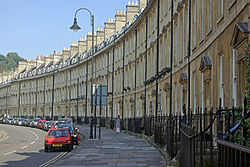The Paragon, Bath
| The Paragon | |
|---|---|
 |
|
| Location | Bath, Somerset, England |
| Coordinates | 51°23′12″N 2°21′36″W / 51.38667°N 2.36000°WCoordinates: 51°23′12″N 2°21′36″W / 51.38667°N 2.36000°W |
| Built | 1768 |
| Architect | Thomas Warr Attwood |
| Architectural style(s) | Georgian |
|
Listed Building – Grade I
|
|
| Official name: Numbers 1 to 21 | |
| Designated | 12 June 1950 |
| Reference no. | 443210 |
|
Listed Building – Grade II
|
|
| Official name: Numbers 22 to 37 | |
| Designated | 12 June 1950 |
| Reference no. | 443211 |
|
Listed Building – Grade II
|
|
| Official name: Walcot Church House | |
| Designated | 11 August 1972 |
| Reference no. | 443213 |
|
Listed Building – Grade II
|
|
| Official name: Walcot Cemetery Gates | |
| Designated | 12 June 1950 |
| Reference no. | 443212 |
The Paragon in the Walcot area of Bath, Somerset, England is a street of Georgian houses which have been designated as listed buildings. It was designed by Thomas Warr Attwood. It now forms part of the A4.
Numbers 1 to 21 are 3 storey houses with mansard roofs. Each building has matching doors and widows with central pediments and flat entablatures either side of the 1st floor windows and Tuscan pilasters and pediments to the doorways.
Numbers 22 to 37 continue the theme from numbers 1 to 21 and were completed in 1775 by Joseph Axford, a local mason. Numbers 28 to 32 were damaged by bombing during World War II but have since been restored.
St Swithin's Church was built between 1779 and 1790 by John Palmer. On 30 May 1797 the abolitionist William Wilberforce and Barbara Spooner Wilberforce were married in the church. It 1805 it was the burial place of the writer and poet Christopher Anstey and, in 1831 of Rear Admiral Sir Edward Berry. The church house which forms number 38 The Paragon was built in the early 18th century. The adjoining cemetery has gates with a rusticated base and panels with inverted torches between pilasters. There is an entablature with metopes and triglyphs.
...
Wikipedia

